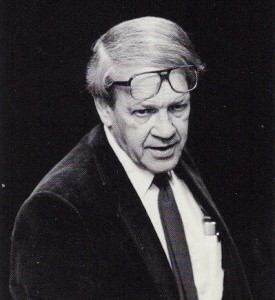The MacDonald Years (1974–1997)

During his career, Paul C. MacDonald, M.D., published more than 300 scientific papers, 96 percent of which came during his years as the Green Center Director. Among the publications was a series of articles on the subject of initiation of parturition (human labor and delivery).
Although methods have been available to induce human labor for many years, information concerning the biochemical and endocrinological basis for the onset of normal labor is still not fully understood.
Infants born prematurely have a high incidence of complications such as respiratory distress due hyaline membrane disease. This disease makes the exchange of gas in the lungs difficult and breathing labored. Respiratory distress occurs when the lungs have not had sufficient time to mature in utero, and the production of a protective molecule, surfactant, is inadequate.
Convinced that preventing prematurity was key to an infant’s survivability and quality of life, Dr. MacDonald and the faculty of the Green Center set about to define the mechanism(s) that resulted in normal human labor. It became a life-long quest of discovery.
Research was by no means confined to parturition. Other investigations included studies of male infertility, the mechanisms which result in problems of sexual differentiation in utero, and studies to explain problems of sexual precosity and gynecomastia (breast formation in men).
The accomplishments of Dr. MacDonald and the team of clinicians and scientists he recruited to the Green Center include:
- Biochemical and molecular foundations of the initiation of human parturition
- Pathophysiology of pregnancy-induced hypertension
- Physiology and pathophysiology of endometrium
- Extraglandular estrogen formation in postmenopausal women and its relationship to obesity, age, and endometrial cancer
- Dehydroepiandrosterone sulfate as a precursor of placental estrogen in human pregnancy
- Human fetal lung development and respiratory distress syndrome
Education during the MacDonald Years
Central to the Green Center’s mission was teaching. In the decade between 1975 and 1985, the Green Center and its affiliated departmental laboratories provided predoctoral, postdoctoral, and health care professional career opportunity training for more than 200 individuals from 26 countries.
Given its research emphasis on the initiation of human labor, the Green Center was a natural venue for training M.D. postdoctoral fellows in reproductive endocrinology and infertility. But the Center also trained postdoctoral fellows in the Ob/Gyn subspecialties of gynecologic oncology and maternal-fetal medicine.
Other trainees included M.D.s and Ph.D.s from the Departments of Biochemistry, Cell Biology, Internal Medicine, Pediatrics, Pharmacology, and Physiology, making the Green Center a diverse learning environment.
"A tireless worker, Dr. MacDonald always found time to offer help and to stimulate young clinicians and scientists. He demanded perfection of himself as well as those with whom he worked, but always gave full credit to the entire team for their successes."
Training was funded in part by the Cecil H. and Ida Green Training International Scholars Program, the Cecil H. and Ida Green Health Profession Career Opportunities Training Program, and National Institutes of Health (NIH) T-32 Training Grant in the Physiology of Reproduction. Additional support was provided by investigator NIH-R01 grants and the Departments of Obstetrics and Gynecology, Biochemistry, Cell Biology, Internal Medicine, Pediatrics, Pharmacology, and Physiology.
JAMA Tribute to Dr. MacDonald
The MacDonald years came to a close when Dr. MacDonald succumbed to disseminated carcinoma on November 25, 1997. In his tribute to Dr. MacDonald published in JAMA, F. Gary Cunningham, M.D., described the man and his contributions thusly:
"He was one of a relatively small group of clinical scientists whose career was spent wedding basic sciences with obstetrics, gynecology, and human reproduction. His earliest scientific discoveries included elucidation of the origin and interconversion of gonadal and adrenal steroid hormones in children, women, and men."
